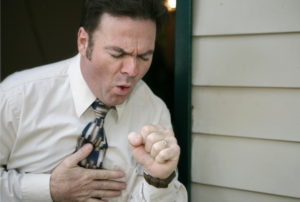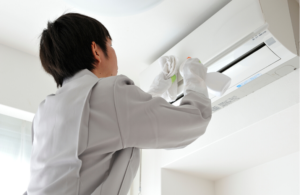There were an estimated 34 million flu illnesses in the 2023-2024 season, with 17,000 deaths. As for the common cold, one person can acquire 3 infections in a single year. That number more than doubles for children, who tend to get sick more frequently.
These people include your customers, employees, and others who visit your facility or business.
Understanding how to help prevent the spread of cold & flu viruses can keep people from getting sick, keep your facility clean and safe, and help you avoid an outbreak that could impact your business.

HOW COLD AND FLU GERMS SPREAD
Both influenza and rhinovirus (the common cold) spread easily and quickly, making them very contagious. Something as simple as a person coughing or sneezing can spread cold and flu germs.
The influenza virus can live on solid, non-porous surfaces up to 24 hours, and up to 15 minutes on porous surfaces like dirty towels or tissues. Elderly individuals, children, and people with weakened immune systems are especially vulnerable to these viruses. So much so that if they acquire an infection from either one, it can be life-threatening and dangerous.
HOW TO PREVENT COLD AND FLU GERMS FROM SPREADING
Use the tips listed below to learn how to help prevent the spread of cold and flu germs in your facility or business.
DISINFECT SURFACES REGULARLY
The best way to keep your facility safe from the spread of cold and flu germs is to clean and disinfect your facility on a regular basis. Follow the cleaning protocols defined for your facility.
To effectively kill germs like Influenza, rhinovirus, and other pathogens that cause sickness, wipe surfaces with an EPA-registered disinfectant, being sure to leave the surface wet for the contact time specified on the disinfectant label.
Not sure how to choose a disinfectant for your business? Take a look at our guide which lists the questions you should ask and factors you should consider before purchasing disinfectant wipes for your facility.

CLEAR THE AIR
One of the most challenging aspects of preventing cold and flu viruses is addressing their tendency to survive and spread when airborne. When people sneeze, cough, talk, laugh, or simply breathe, they propel microscopic liquid droplets into the air.
When someone is carrying cold or flu viruses, those same water droplets can contaminate your entire facility. In fact, the flu can travel up to six feet away from an infected person through airborne travel, according to the Center for Disease Control. This makes the air quality in your facility very important.
The Environmental Protection Agency says “Air cleaning and filtration can help reduce airborne contaminants, including particles containing viruses.”
To help minimize the presence of cold and flu viruses, be sure your air filtration system is installed and working properly:
- Invest in an air filtration system if you don’t have one.
- Check and change your air filters and ventilators seasonally.
- Clean and disinfect your air filtering system regularly, according to the manufacturer’s instructions.
AMP UP YOUR CLEANING FREQUENCY
During the cold-weather months, people have no choice but to spend more time indoors. Considering that more people get sick in winter months, it’s wise to adjust accordingly and clean your facility more often.
Below-freezing temperatures make spending time inside a necessity. Increased traffic means that surfaces will be getting touched more often. Since influenza and rhinovirus are highly contagious and can linger for hours, cleaning more often can help prevent them from spreading.
Here’s how to prevent cold and flu by amping up your cleaning frequency:
- Disinfect high-touch surfaces like door handles, reception desks, phones, and water dispensers and at least twice a day.
- Double your deep cleaning: If you currently deep clean once a week, bump it up to two for the cold and flu season.
- Provide disinfecting wipes and hand sanitizers in high-traffic areas and encourage employees or guests to use them. Consider investing in stands and dispensers for your facility to make these items easily accessible.

PAY ATTENTION TO SMALL HIGH TOUCH SURFACES
Office keyboards contain thousands of microbes per square inch, 48% of microwave door handles contain harmful bacteria, and office phones and headsets tested positive for an average of over 20,000 germs per square inch. Even an average computer mouse harbors around 1,700 germs per square inch, proving that small surfaces can cause big problems if they’re not cleaned properly and regularly.
Disinfect these often-overlooked small high-touch surfaces at least every other day to kill cold and flu germs, and others:
- Door knobs, sink handles, coffee pot handles, and refrigerator handles
- Cell phones, desk phones, and headsets
- Computer equipment like keyboards and mice
PUT UP SIGNS AND REMINDERS
Who knows why some people don’t wash their hands, clean up behind themselves, or practice good hygiene. Bad habits, not being trained or educated on the importance of cleaning, being distracted or tired, or just plain old forgetting could be a few of them. To help remind customers and employees to keep it clean to prevent cold and flu from spreading, signs and posters can help.
Doing so can begin to create a culture of clean while helping to change behavior, promote cleanliness, and keep your facility safe. No matter how diligent you are with your cleaning, sanitizing, and disinfecting efforts, all it takes is one infected person sneezing or touching a surface to destroy the virtue of all of your hard work.
Help people to keep areas clean by posting signs and posters with specific hygiene tips to help prevent the spread of germs – make your signs bold and prominent so they are noticed.
Possible signs to keep your facility safe include the following:
- Encourage proper handwashing with soap and water for at least 20 seconds.
- Ask visitors and employees to sneeze into their elbow to avoid germs touching hands.
- Remind guests and employees to stay home if they aren’t feeling well and list out the incubation period for cold & flu viruses.

STOP THE SPREAD
Maintaining a clean, healthy, safe environment isn’t only a good business practice, it’s the right thing to do. With several record-breaking flu seasons occurring in the past decade, more people are increasingly at risk of becoming sick than ever before. With the above tips you can do your part to help stop the spread of cold and flu viruses amongst your customers and employees in your facility.
